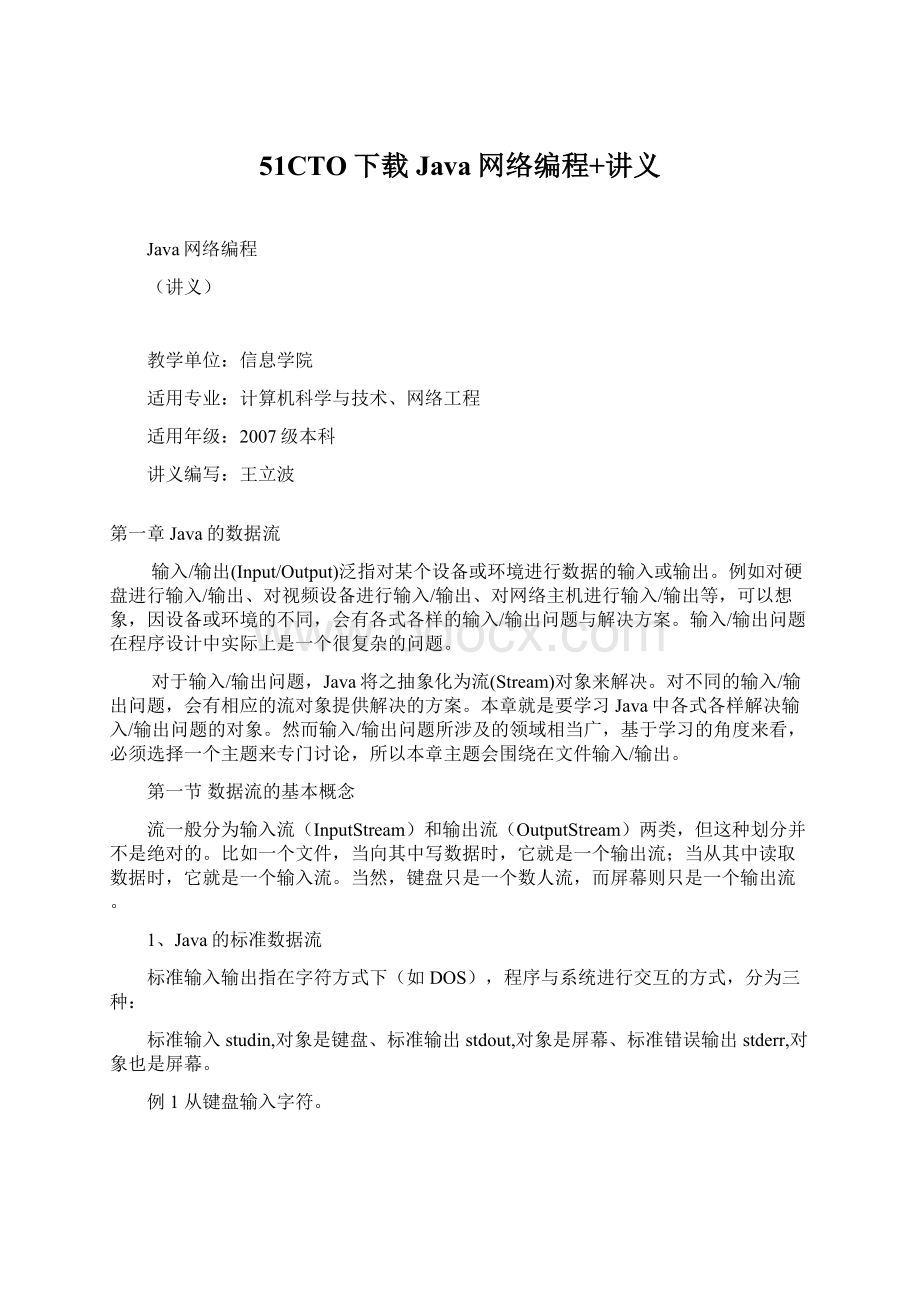 51CTO下载Java网络编程+讲义Word文件下载.docx
51CTO下载Java网络编程+讲义Word文件下载.docx
- 文档编号:20457712
- 上传时间:2023-01-23
- 格式:DOCX
- 页数:98
- 大小:86.74KB
51CTO下载Java网络编程+讲义Word文件下载.docx
《51CTO下载Java网络编程+讲义Word文件下载.docx》由会员分享,可在线阅读,更多相关《51CTO下载Java网络编程+讲义Word文件下载.docx(98页珍藏版)》请在冰豆网上搜索。

"
);
bytebuffer[]=newbyte[512];
//输入缓冲区
intcount=System.in.read(buffer);
//读取标准输入流
Output:
for(inti=0;
i<
COUNT;
I++){//输出buffer元素值
System.out.print("
+buffer[i]);
}
System.out.println();
I++){//按字符方式输出buffer
System.out.print((char)buffer[i]);
count="
+count);
//buffer实际长度
程序中,main方法采用throws子句抛出IOException异常交由系统处理。
2、java.io包中的数据流及文件类
字节流:
从InputStream和OutputStream派生出来的一系列类。
这类流以字节(byte)为基本处理单位。
◇InputStream、OutputStream
◇FileInputStream、FileOutputStream
◇PipedInputStream、PipedOutputStream
◇ByteArrayInputStream、ByteArrayOutputStream
◇FilterInputStream、FilterOutputStream
◇DataInputStream、DataOutputStream
◇BufferedInputStream、BufferedOutputStream
字符流:
从Reader和Writer派生出的一系列类,这类流以16位的Unicode码表示的字符为基本处理单位。
◇Reader、Writer
◇InputStreamReader、OutputStreamWriter
◇FileReader、FileWriter
◇CharArrayReader、CharArrayWriter
◇PipedReader、PipedWriter
◇FilterReader、FilterWriter
◇BufferedReader、BufferedWriter
◇StringReader、StringWriter
第二节字节流初步
InputStream和OutputStream
read():
从流中读入数据
skip():
跳过流中若干字节数
available():
返回流中可用字节数
mark():
在流中标记一个位置
reset():
返回标记过得位置
markSupport():
是否支持标记和复位操作
close():
关闭流
intread()从输入流中读一个字节,形成一个0~255之间的整数返回(是一个抽象方法)。
intread(byteb[])读多个字节到数组中。
intread(byteb[],intoff,intlen)
write(intb)将一个整数输出到流中(只输出低位字节,抽象)
write(byteb[])将字节数组中的数据输出到流中
write(byteb[],intoff,intlen)将数组b中从off指定的位置开始,长度为len的数据输出到流中
flush():
刷空输出流,并将缓冲区中的数据强制送出
从输入流中读取长度为len的数据,写入数组b中从索引off开始的位置,并返回读取得字节数。
进行I/O操作时可能会产生I/O例外,属于非运行时例外,应该在程序中处理。
如:
型FileNotFoundException,EOFException,IOException
例2打开文件。
本例以FileInputStream的read(buffer)方法,每次从源程序文件OpenFile.java中读取512个字节,存储在缓冲区buffer中,再将以buffer中的值构造的字符串newString(buffer)显示在屏幕上。
publicclassOpenFile{
publicstaticvoidmain(Stringargs[])throwsIOException{
try{//创建文件输入流对象
FileInputStreamrf=newFileInputStream("
OpenFile.java"
intn=512;
bytebuffer[]=newbyte[n];
while((rf.read(buffer,0,n)!
=-1)&
&
(n>
0))//读取输入流
{System.out.print(newString(buffer));
}
rf.close();
//关闭输入流
}catch(IOExceptionioe){System.out.println(ioe);
catch(Exceptione){System.out.println(e);
例3写入文件。
本例用System.in.read(buffer)从键盘输入一行字符,存储在缓冲区buffer中,再以FileOutStream的write(buffer)方法,将buffer中内容写入文件Write1.txt中,程序如下:
publicclassWrite1{
publicstaticvoidmain(Stringargs[]){
try{
intcount,n=512;
count=System.in.read(buffer);
FileOutputStreamwf=newFileOutputStream("
Write1.txt"
//创建文件输出流对象
wf.write(buffer,0,count);
//写入输出流
wf.close();
//关闭输出流
SavetoWrite1.txt!
"
}catch(IOExceptionioe){
System.out.println(ioe);
}catch(Exceptione){
System.out.println(e);
第三节文件操作
1、File类
File类声明如下:
publicclassFileectendsObjectimplementsSerializable,Comparable
构造方法:
publicFile(Stringpathname)
publicFile(Filepatent,Stringchile)
publicFile(Stringpatent,Stringchild)
2、文件名的处理
StringgetName();
//得到一个文件的名称(不包括路径)
StringgetPath();
//得到一个文件的路径名
StringgetAbsolutePath();
//得到一个文件的绝对路径名
StringgetParent();
//得到一个文件的上一级目录名
StringrenameTo(FilenewName);
//将当前文件名更名为给定文件的完整路径文件属性测试
booleanexists();
//测试当前File对象所指示的文件是否存在
booleancanWrite();
//测试当前文件是否可写
booleancanRead();
//测试当前文件是否可读
booleanisFile();
//测试当前文件是否是文件(不是目录)
booleanisDirectory();
//测试当前文件是否是目录
3、普通文件信息和工具
longlastModified();
//得到文件最近一次修改的时间
longlength();
//得到文件的长度,以字节为单位
booleandelete();
//删除当前文件
4、目录操作
booleanmkdir();
//根据当前对象生成一个由该对象指定的路径
Stringlist();
//列出当前目录下的文件
例4自动更新文件。
本例使用File类对象对指定文件进行自动更新的操作。
importjava.util.Date;
importjava.text.SimpleDateFormat;
publicclassUpdateFile{
publicstaticvoidmain(Stringargs[])throwsIOException{
Stringfname="
;
//待复制的文件名
Stringchilddir="
backup"
//子目录名
newUpdateFile().update(fname,childdir);
publicvoidupdate(Stringfname,Stringchilddir)throwsIOException{
Filef1,f2,child;
f1=newFile(fname);
//当前目录中创建文件对象f1
child=newFile(childdir);
//当前目录中创建文件对象child
if(f1.exists()){
if(!
child.exists())//child不存在时创建子目录
child.mkdir();
f2=newFile(child,fname);
//在子目录child中创建文件f2
f2.exists()||//f2不存在时或存在但日期较早时
f2.exists()&
(f1.lastModified()>
f2.lastModified()))
copy(f1,f2);
//复制
getinfo(f1);
getinfo(child);
}else
System.out.println(f1.getName()+"
filenotfound!
publicvoidcopy(Filef1,Filef2)throwsIOException{
FileInputStreamrf=newFileInputStream(f1);
//创建文件输入流对象
FileOutputStreamwf=newFileOutputStream(f2);
//创建文件输出流对象
count=rf.read(buffer,0,n);
//读取输入流
while(count!
=-1){
CopyFile"
+f2.getName()+"
!
publicstaticvoidgetinfo(Filef1)throwsIOException{
SimpleDateFormatsdf;
sdf=newSimpleDateFormat("
yyyy年MM月dd日hh时mm分"
if(f1.isFile())
<
FILE>
\t"
+f1.getAbsolutePath()+"
+
f1.length()+"
+sdf.format(newDate(f1.lastModified())));
else{
\t"
+f1.getAbsolutePath());
File[]files=f1.listFiles();
FILES.LENGTH;
I++)
getinfo(files[i]);
f1.lastModified()返回一个表示日期的长整型,值为从1970年1月1日零时开始计算的毫秒数,并以此长整型构造一个日期对象,再按指定格式输出日期。
5、文件过滤器
类FilterInputStream和FilterOutputStream分别对其他输入/输出流进行特殊处理,它们在读/写数据的同时可以对数据进行特殊处理。
另外还提供了同步机制,使得某一时刻只有一个线程可以访问一个输入/输出流。
类FilterInputStream和FilterOutputStream分别重写了父类InputStream和OutputStream的所有方法,同时,它们的子类也应该重写它们的方法以满足特定的需要。
要使用过滤流,首先必须把它连接到某个输入/输出流上,通常在构造方法的参数中指定所要连接的流:
FilterInputStream(InputStreamin);
FilterOutputStream(OutputStreamout);
这两个类是抽象类,构造方法也是保护方法。
类BufferedInputStream和BufferedOutputStream实现了带缓冲的过滤流,它提供了缓冲机制,把任意的I/O流“捆绑”到缓冲流上,可以提高读写效率。
在初始化时,除了要指定所连接的I/O流之外,还可以指定缓冲区的大小。
缺省大小的缓冲区适合于通常的情形;
最优的缓冲区大小常依赖于主机操作系统、可使用的内存空间以及机器的配置等;
一般缓冲区的大小为内存页或磁盘块等地整数倍,如8912字节或更小。
BufferedInputStream(InputStreamin[,intsize])
BufferedOutputStream(OutputStreamout[,intsize])
例5列出当前目录中带过滤器的文件名清单。
本例实现FilenameFilter接口中的accept方法,在当前目录中列出带过滤器的文件名。
publicclassDirFilterimplementsFilenameFilter{
privateStringprefix="
suffix="
//文件名的前缀、后缀
publicDirFilter(Stringfilterstr){
filterstr=filterstr.toLowerCase();
inti=filterstr.indexOf('
*'
intj=filterstr.indexOf('
.'
if(i>
0)
prefix=filterstr.substring(0,i);
if(j>
suffix=filterstr.substring(j+1);
FilenameFilterfilter=newDirFilter("
w*abc.txt"
//创建带通配符的文件名过滤器对象
Filef1=newFile("
Filecurdir=newFile(f1.getAbsolutePath(),"
//当前目录
System.out.println(curdir.getAbsolutePath());
String[]str=curdir.list(filter);
//列出带过滤器的文件名清单
STR.LENGTH;
+str[i]);
publicbooleanaccept(Filedir,Stringfilename){
booleanyes=true;
try{
filename=filename.toLowerCase();
yes=(filename.startsWith(prefix))&
(filename.endsWith(suffix));
}catch(NullPointerExceptione){}
returnyes;
程序运行时,列出当前目录中符合过滤条件“w*.txt“的文件名清单。
6、随机文件操作
对于InputStream和OutputStream来说,它们的实例都是顺序访问流,也就是说,只能对文件进行顺序地读/写。
随机访问文件则允许对文件内容进行随机读/写。
在java中,类RandomAccessFile提供了随机访问文件的方法。
类RandomAccessFile的声明为:
publicclassRandomAccessFileextendsObjectimplementsDataInput,DataOutput
File:
以文件路径名的形式代表一个文件
FileDescriptor:
代表一个打开文件的文件描述
FileFilter&
FilenameFilter:
用于列出满足条件的文件
File.list(FilenameFilterfnf)
File.listFiles(FileFilterff)
FileDialog.setFilenameFilter(FilenameFilterfnf)
FileInputStream&
FileReader:
顺序读文件
FileOutputStream&
FileWriter:
顺序写文件
RandomAccessFile:
提供对文件的随机访问支持
类RandomAccessFile则允许对文件内容同时完成读和写操作,它直接继承Object,并且同时实现了接口DataInput和DataOutput,提供了支持随机文件操作的方法
DataInput和DataOutput中的方法
readInt(),writeDouble()…
intskipBytes(intn):
将指针乡下移动若干字节
length():
返回文件长度
longgetFilePointer():
返回指针当前位置
voidseek(longpos):
将指针调到所需位置
voidsetLength(longnewLength):
设定文件长度
RandomAccessFile(Filefile,Stringmode)
RandomAccessFile(Stringname,Stringmode)
mode的取值
“r”只读.任何写操作都将抛出IOException。
“rw”读写.文件不存在时会创建该文件,文件存在时,原文件内容不变,通过写操作改变文件内容。
“rws”同步读写.等同于读写,但是任何协操作的内容都被直接写入物理文件,包括文件内容和文件属性。
“rwd”数据同步读写.等同于读写,但任何内容写操作都直接写到物理文件,对文件属性内容的修改不是这样。
例6随机文件操作。
本例对一个二进制整数文件实现访问操作当以可读写方式“rw“打开一个文件”prinmes.bin“时,如果文件不存在,将创建一个新文件。
先将2作为最小素数写入文件,再依次测试100以内的奇数,将每次产生一个素数写入文件尾。
publicclassPrimesFile{
RandomAccessFileraf;
(newPrimesFile()).createprime(100);
publicvoidcreateprime(intmax)throwsIOException{
raf=newRandomAccessFile("
primes.bin"
"
rw"
//创建文件对象
raf.seek(0);
//文件指针为0
raf.writeInt
(2);
//写入整型
intk=3;
while(k<
=max){
if(isPrime(k))
raf.writeInt(k);
k=k+2;
output(max);
raf.close();
//关闭文件
publicbooleanisPrime(intk)throwsIOException{
inti=0,j;
boo
- 配套讲稿:
如PPT文件的首页显示word图标,表示该PPT已包含配套word讲稿。双击word图标可打开word文档。
- 特殊限制:
部分文档作品中含有的国旗、国徽等图片,仅作为作品整体效果示例展示,禁止商用。设计者仅对作品中独创性部分享有著作权。
- 关 键 词:
- 51 CTO 下载 Java 网络 编程 讲义
 冰豆网所有资源均是用户自行上传分享,仅供网友学习交流,未经上传用户书面授权,请勿作他用。
冰豆网所有资源均是用户自行上传分享,仅供网友学习交流,未经上传用户书面授权,请勿作他用。


 如何打造酒店企业文化2刘田江doc.docx
如何打造酒店企业文化2刘田江doc.docx
